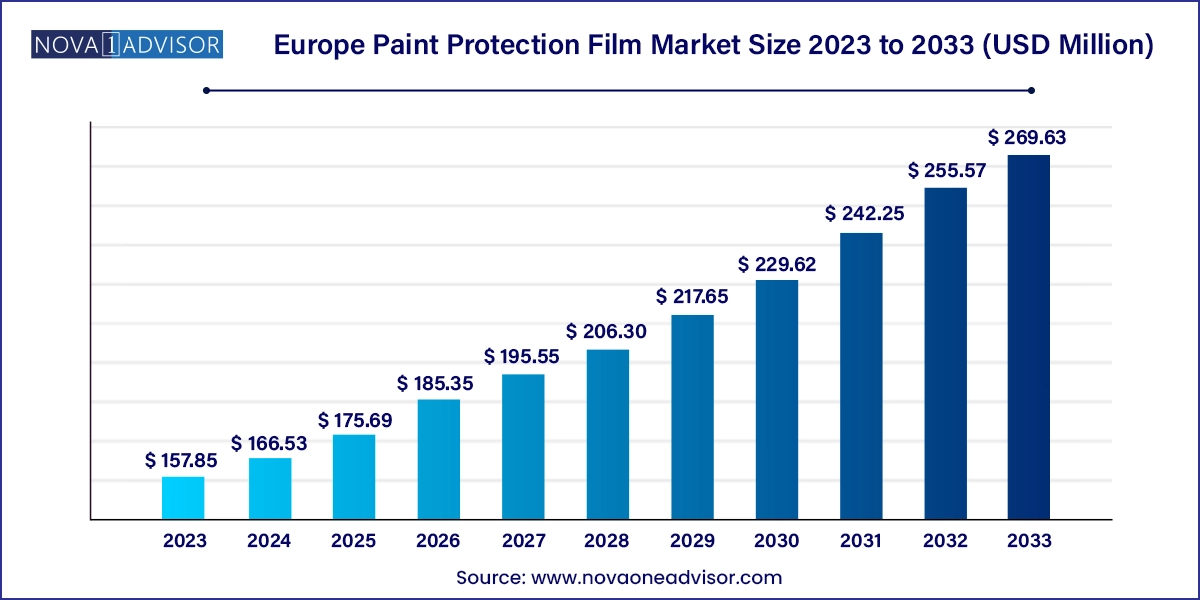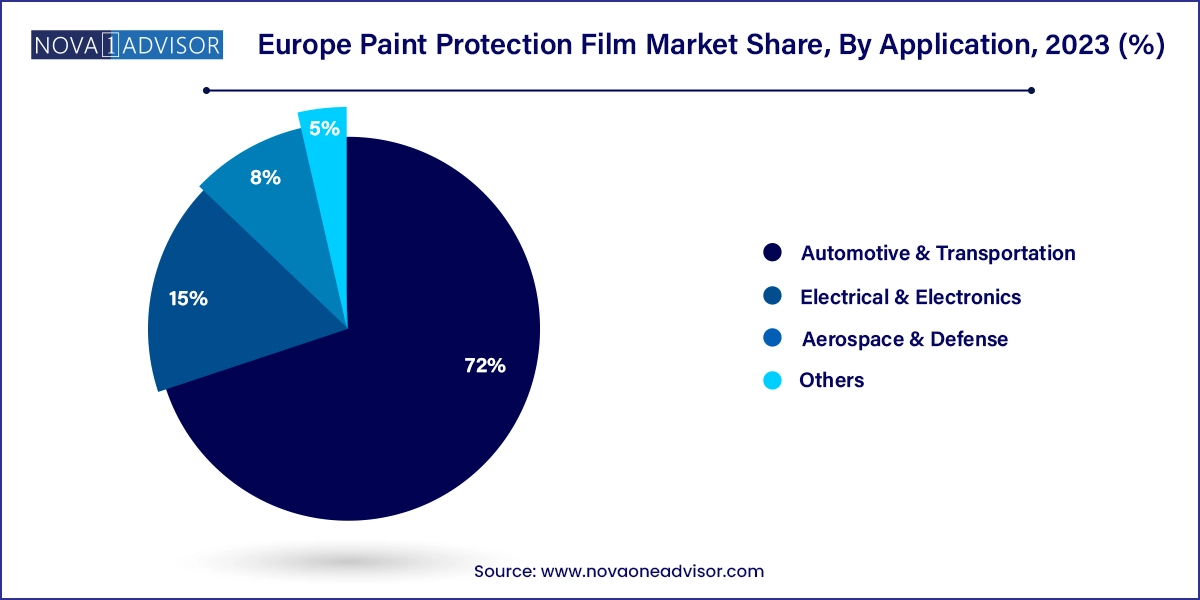Europe Paint Protection Film Market Size and Growth
The Europe paint protection film market size was exhibited at USD 157.85 million in 2023 and is projected to hit around USD 269.63 million by 2033, growing at a CAGR of 5.5% during the forecast period 2024 to 2033.

Europe Paint Protection Film Market Key Takeaways:
- The thermoplastic polyurethane (TPU) segment dominated the market with a share of 83.5% in 2023.
- The polyvinyl chloride (PVC) segment is projected to grow at a CAGR of 22.6% from 2024 to 2033.
- The automotive & transportation sector held the largest revenue share of 72.0% in 2023.
- The electrical and electronics segment is projected to grow at a CAGR of 5.1% over the forecast period.
Market Overview
The Europe Paint Protection Film (PPF) Market has been steadily growing, fueled by the rise in luxury vehicle ownership, a greater emphasis on vehicle aesthetics and longevity, and technological advancements in film manufacturing. Paint Protection Films are ultra-thin polyurethane or polymer-based films applied to surfaces most commonly on automobiles to protect against scratches, stone chips, UV degradation, corrosion, and general wear and tear. In a region like Europe, with its historic automotive culture, diverse climates, and dense urban environments, the demand for paint preservation solutions is significant.
Europe is home to some of the world’s most prestigious automotive brands such as BMW, Mercedes-Benz, Porsche, Audi, and Jaguar, and the luxury vehicle market continues to grow steadily. Paint protection has become not only a performance consideration but also a lifestyle-driven choice. Beyond automotive use, the PPF market in Europe is branching out into electronics (screen protection), aerospace (surface longevity), and defense (anti-corrosion coating).
The European market is defined by strict quality standards, an inclination toward sustainability, and growing consumer awareness. Environmental regulations have also influenced the shift from solvent-based coatings to PPF solutions that are cleaner and longer-lasting. Furthermore, the surge in e-mobility and EV ownership driven by government incentives has amplified consumer investment in maintaining vehicle aesthetics and value, thus propelling the demand for paint protection solutions.
Major Trends in the Market
-
Rising Demand for Self-Healing and Hydrophobic Films: These films can automatically eliminate minor scratches and repel water and contaminants, improving durability and aesthetics.
-
OEM Integration of PPF: Luxury car manufacturers are now offering factory-installed PPF or dealer-installed options as part of premium packages.
-
Increasing Use in Two-Wheelers and E-Bikes: The urban mobility revolution has brought electric scooters and bikes into the fold for PPF applications.
-
Preference for Matte and Textured Finishes: European consumers are seeking aesthetic customization with satin or matte PPF variants, especially in the luxury segment.
-
Digitization of Installation via Pre-Cut Templates: Pre-cut software and CAD-enabled systems ensure precise installations, reducing waste and installer labor.
-
Growth in DIY and Subscription-Based Models: More European consumers are engaging with DIY PPF kits for gadgets and entry-level vehicles, while detailing centers are exploring subscription models for PPF maintenance.
-
Eco-Friendly Material Innovation: Companies are focusing on bio-based TPU alternatives and solvent-free adhesives, driven by the EU’s focus on sustainability.
Report Scope of Europe Paint Protection Film Market
| Report Coverage |
Details |
| Market Size in 2024 |
USD 166.53 Million |
| Market Size by 2033 |
USD 269.63 Million |
| Growth Rate From 2024 to 2033 |
CAGR of 5.5% |
| Base Year |
2023 |
| Forecast Period |
2024-2033 |
| Segments Covered |
Material, Application, country |
| Market Analysis (Terms Used) |
Value (US$ Million/Billion) or (Volume/Units) |
| Country scope |
Germany; UK; France |
| Key Companies Profiled |
3M; Eastman Chemical Company; Avery Dennison Corp.; Saint-Gobain Group; Renolit SE; DuPont de Nemours, Inc.; BASF SE; Imerys S.A.; XPEL Inc.; Hexis |
Key Market Driver: Growth of the European Luxury and Electric Vehicle Market
The most powerful growth driver in the European PPF market is the expanding luxury car and electric vehicle segment, which is reshaping the way consumers view vehicle ownership. Germany, France, and the UK are major markets for high-end brands like BMW, Audi, Mercedes, and Jaguar. Owners of these vehicles seek to maintain a "showroom finish" throughout the lifecycle of the car.
The shift toward electric mobility is adding a new dimension. Electric vehicles (EVs), with their unique designs, often carry higher initial costs and are purchased by tech-savvy consumers who value premium aftercare. PPF offers an effective solution to preserve the paint integrity of EVs especially in light of government incentives encouraging longer vehicle use to reduce carbon footprints. For instance, Tesla owners across Europe are among the highest users of aftermarket PPF services, often opting for full-body protection.
OEMs are also integrating PPF into vehicle design phases. For example, luxury models are now offering PPF as an upsell option, sometimes installed before delivery to reduce aftermarket intervention.
Key Market Restraint: High Installation Costs and Market Fragmentation
A prominent barrier in the European PPF market is the high cost of material and professional installation, particularly when compared to traditional wax or ceramic coatings. TPU-based PPF, which dominates due to its superior clarity and self-healing properties, comes at a premium both in production and application. Full-body installations can cost several thousand euros, putting them out of reach for average car buyers.
Moreover, the market is highly fragmented, with inconsistent quality standards across installers, particularly in the aftermarket. Consumers often face challenges distinguishing between genuine TPU-based PPF and inferior vinyl-based alternatives. This results in occasional buyer skepticism, impacting overall trust in PPF solutions.
Additionally, although larger urban areas have dedicated detailing studios, rural and suburban regions in Europe still lack professional PPF service centers, further limiting market penetration. Bridging this geographical and pricing gap is essential for the broader adoption of PPF across income and location brackets.
Key Market Opportunity: Growth in Consumer Electronics and Wearables
An exciting growth avenue for the PPF market in Europe is its application in electronics and wearables, including smartphones, tablets, smartwatches, laptops, and foldable displays. These devices are increasingly fragile, expensive, and heavily used, prompting consumers to invest in premium surface protection solutions.
As the European population embraces remote work, BYOD (Bring Your Own Device) setups, and portable electronics, there is a growing demand for PPF films that are ultra-clear, oleophobic, and anti-microbial. Smartphone manufacturers and accessory brands are exploring co-branded or OEM-installed protective films, often applying PPF directly to glass panels, camera lenses, and touchscreens.
Moreover, with foldable phones and curved screens becoming more prevalent, PPF offers a better protective solution than rigid glass-based protectors. As devices become more flexible, conventional screen guards fail to offer the needed versatility, giving PPF an upper hand in both commercial and retail channels.
Europe Paint Protection Film Market By Material Insights
Thermoplastic Polyurethane (TPU) dominated the Europe Paint Protection Film market, largely due to its superior mechanical properties, clarity, and resistance to UV radiation and minor abrasions. TPU is highly flexible, conforms seamlessly to curved surfaces, and possesses excellent self-healing capabilities under heat. In automotive applications, it is particularly favored for high-exposure zones such as bumpers, hoods, mirrors, and door handles. Leading brands in Germany, France, and the UK rely extensively on TPU-based films for both aftermarket detailing and OEM integration.
Polyvinyl Chloride (PVC) is the fastest-growing segment, especially among value-conscious consumers and in entry-level or commercial vehicles. While PVC lacks the elasticity and clarity of TPU, its affordability makes it a preferred option for mass-market use. Detailers in suburban and rural areas across Eastern Europe, in particular, use PVC-based films to offer basic protection packages for delivery vans, taxis, and budget cars. The increasing refinement in PVC formulations is also closing the gap in optical quality and longevity.
Europe Paint Protection Film Market By Application Insights
Automotive & Transportation is the dominant application, representing the core use case for paint protection films across Europe. From luxury vehicles in Germany to performance cars in the UK and urban EVs in France, European consumers are increasingly investing in surface protection to preserve resale value and reduce repainting costs. The emergence of auto detailing studios and mobile PPF units has further fueled the adoption of PPF as a lifestyle and maintenance solution.

Electrical & Electronics is the fastest-growing application segment, bolstered by the booming consumer tech market in Europe. Smartphone sales, laptop distribution for remote work, and the rising use of tablets in education have created vast opportunities for PPF manufacturers. Films tailored for curved glass, matte finishes, and anti-smudge surfaces are being adopted by both OEMs and accessory manufacturers. The UK, in particular, has seen a surge in demand for PPF-based screen protectors, owing to high smartphone penetration and a tech-savvy consumer base.
Country Insights
Germany
Germany is the largest PPF market in Europe, driven by its globally renowned automotive industry. German car owners are highly brand-conscious and view PPF as a value-preserving tool. Cities like Stuttgart, Munich, and Frankfurt are home to large clusters of detailing studios offering high-end PPF services, often bundled with ceramic coatings. Luxury brands such as Mercedes-Benz, Porsche, and BMW are also exploring in-factory or dealership-level PPF application options.
France
France is emerging as a PPF innovation and sustainability hub. Companies are experimenting with bio-based TPU films and solvent-free adhesive technologies to align with France’s environmental regulations. French consumers, especially in urban areas like Paris and Lyon, are embracing PPF to protect EVs and lease vehicles. Additionally, the rise of e-scooters and shared micro-mobility solutions in cities is opening a niche market for PPF on personal and fleet e-mobility devices.
United Kingdom
The UK is a fast-growing and highly diversified market for PPF, fueled by rising luxury vehicle registrations and strong penetration of detailing chains. Car enthusiasts and collectors across London, Manchester, and Birmingham routinely opt for full-body PPF coverage for their vintage and exotic cars. Post-Brexit trade realignments have also led to increased investments in domestic PPF production and innovation, with UK-based startups exploring anti-microbial and digitally printed protective films.
Europe Paint Protection Film Market Recent Developments
- In February 2024, XPEL, Inc. launched several new asset protection products including its first-ever windshield protection film and additions to its surface care line, all available worldwide in Q3 2024
- In June 2023, Hexis rolled out a new recycling program across its converting network in France, enabling the recovery of various film materials for industrial reuse through partnerships established by its QHSE team
- In May 2024, Tint World Automotive Styling Centers partnered with XPEL to offer premium protective films and coatings for various applications to its growing international franchise network
Some of the prominent players in the Europe paint protection film market include:
- 3M
- Eastman Chemical Company
- Avery Dennison Corporation
- Renolit SE
- DuPont de Nemours, Inc.
- BASF SE
- Saint-Gobain Group
- XPEL Inc.
- Imerys S.A.
- Hexis
Segments Covered in the Report
This report forecasts revenue growth at country levels and provides an analysis of the latest industry trends in each of the sub-segments from 2021 to 2033. For this study, Nova one advisor, Inc. has segmented the Europe paint protection film market
Material
- Thermoplastic Polyurethane (TPU)
- Polyvinyl chloride (PVC)
- Others
Application
- Automotive & Transportation
- Electrical & Electronics
- Aerospace & Defense
- Others
Country


